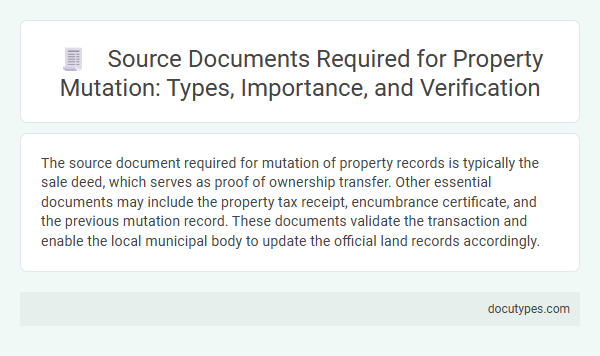The source document required for mutation of property records is typically the sale deed, which serves as proof of ownership transfer. Other essential documents may include the property tax receipt, encumbrance certificate, and the previous mutation record. These documents validate the transaction and enable the local municipal body to update the official land records accordingly.
Introduction to Property Mutation
Mutation of property records is the process of updating ownership details in government records after a property is sold or transferred. This process ensures that the new owner's name is officially recorded and reflected in property documents.
Mutation is essential for property tax purposes and for establishing legal ownership in case of disputes.
- Sale Deed - The primary source document that proves the transfer of ownership between the seller and buyer.
- Property Tax Receipts - Documents showing that the property tax has been paid by the current or previous owner, supporting the ownership claim.
- Encumbrance Certificate - A legal document ensuring the property is free from any monetary or legal liabilities before mutation is processed.
What is Property Mutation?
Property mutation is the process of updating ownership details in government land records after the transfer of property from one person to another. This legal procedure ensures that the new owner's name is officially recorded in municipal or land revenue records.
The source document required for the mutation of property records is primarily the sale deed or conveyance deed that serves as proof of ownership transfer. Other supporting documents, such as the property tax receipt, mutation application form, and identity proof, may also be necessary during the mutation process.
- Property Mutation - A legal process that updates ownership details in land records after property transfer.
- Source Document - The sale deed is the key document required for initiating property mutation.
- Supporting Documents - Additional documents include tax receipts, mutation application, and identity proofs to complete the mutation process.
Importance of Property Mutation in Real Estate
Property mutation is the official process of updating the ownership details in government records after the sale or transfer of property. The source document required for mutation primarily includes the sale deed or transfer deed, which legally proves the change of ownership.
Mutation is crucial in real estate as it ensures the new owner is recognized in municipal and revenue records, enabling them to pay property taxes and access civic amenities. Without proper mutation, the owner may face legal disputes and difficulties in future transactions or claims related to the property.
Types of Property Mutation
| Source Document Required for Mutation | The primary source document required for the mutation of property records is the legal proof of ownership change. This includes sale deeds, gift deeds, succession certificates, or partition deeds, depending on the nature of the property transfer. |
|---|---|
| Types of Property Mutation |
|
Key Source Documents Required for Property Mutation
The source document required for mutation of property records is essential to legally update ownership details in government records. Key source documents include the sale deed, property tax receipts, and the latest encumbrance certificate. You must provide these documents to ensure a smooth mutation process for accurate property record-keeping.
Step-by-Step Guide to Collecting Mutation Documents
Mutation of property records requires specific source documents to update ownership details officially. Collecting the correct documents ensures a smooth mutation process without legal complications.
- Sale Deed - The primary document proving the transfer of ownership from seller to buyer.
- Property Tax Receipts - Recent tax payment receipts to confirm no dues are outstanding on the property.
- Encumbrance Certificate - A certificate indicating the property is free from legal or monetary liabilities.
Gathering these documents carefully helps expedite the mutation process and secures legitimate property records.
Common Types of Source Documents for Mutation
Source documents are essential for the mutation of property records as they provide legal proof of ownership transfer or changes in property details. These documents ensure that the mutation process is clear, transparent, and legally valid.
Common types of source documents for property mutation include sale deeds, gift deeds, and inheritance certificates. Other documents such as partition deeds, court orders, and property tax receipts may also be required depending on the nature of the mutation.
Verification Process of Mutation Source Documents
The source document required for mutation of property records is typically the sale deed, gift deed, or inheritance document, depending on the nature of ownership transfer. This document serves as legal proof to update the ownership details in government records.
The verification process of mutation source documents involves a thorough examination by the local municipal or revenue authorities to ensure authenticity and accuracy. Authorities cross-check the submitted documents against existing records to prevent fraudulent claims. You must provide original copies and valid identity proofs during this process to facilitate smooth mutation approval.
Legal Implications of Incorrect or Missing Documents
What is the source document required for mutation of property records? The source document typically includes the registered sale deed, gift deed, or inheritance deed that legally proves ownership transfer. These documents ensure the mutation process is valid and helps maintain accurate land revenue records.
What are the legal implications of incorrect or missing documents during property mutation? Incorrect or missing documents can lead to disputes, legal challenges, and delays in property ownership recognition. You may face difficulties in proving ownership, which can impact your ability to sell the property or obtain loans against it.
What Is the Source Document Required for Mutation of Property Records? Infographic

